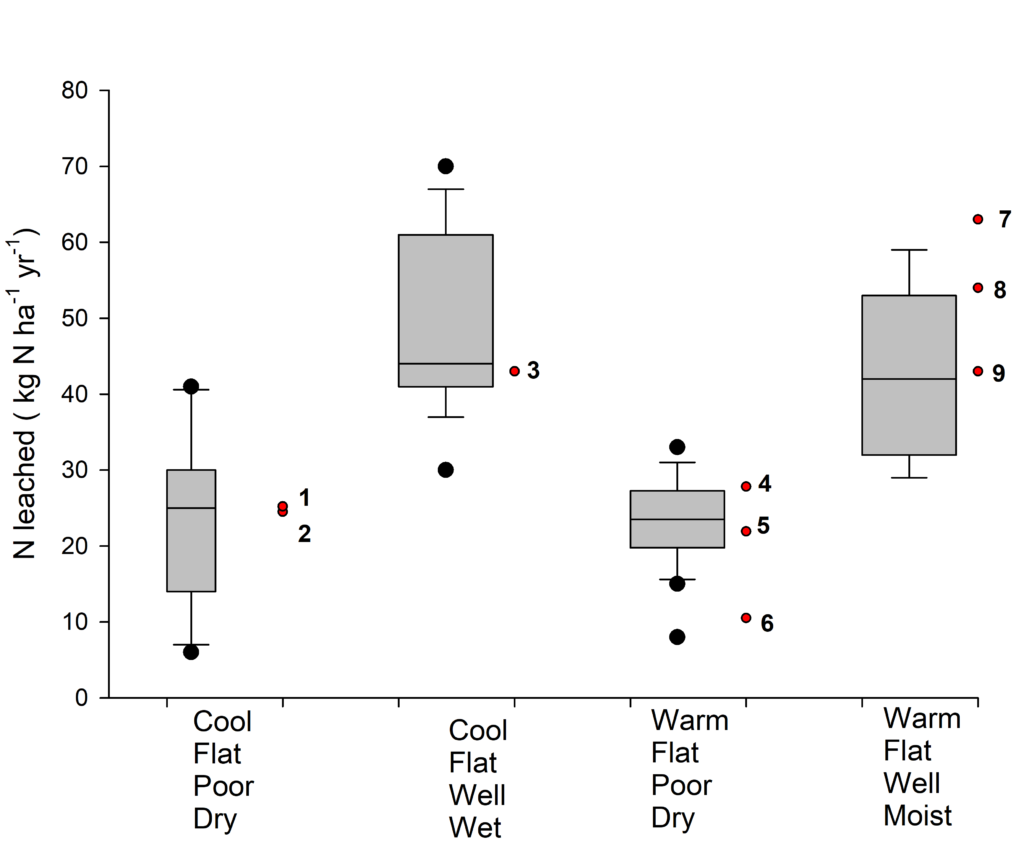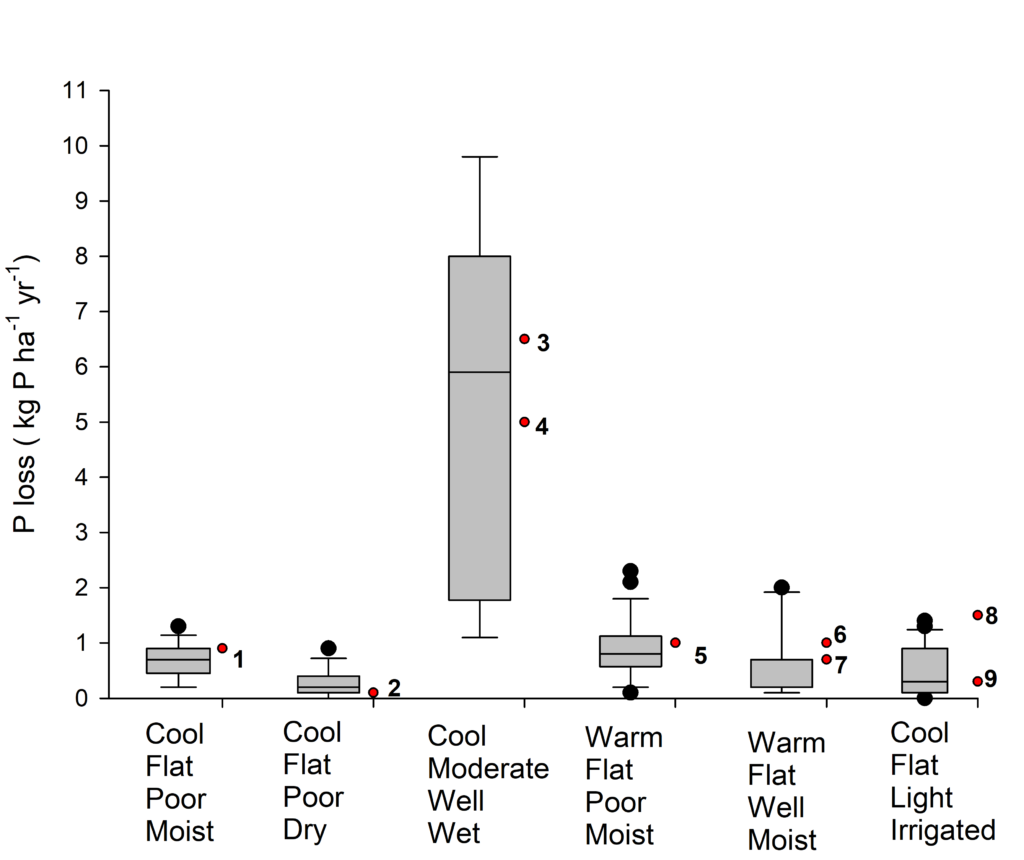Measurements Add Confidence to Analysis of Mitigation Effectiveness
We found that modelling was a fair match to reality when we compared real world dairy farm measurements to modelling used in research that developed 20 new dairy 'typologies' to estimate the effectiveness of farmer actions to reduce contaminant loss to water between 1995 and 2015. This adds a layer of confidence to our analysis.
Contaminant loss estimates from modelling aiming to capture the diversity of New Zealand pastoral farms have proved to be a fair match to real word dairy farm measurements, adding a layer of confidence to the analysis.
When researchers in the Our Land and Water National Science Challenge Sources and Flows programme compared modelled losses of nitrogen (N) and phosphorus (P) with actual losses, the range of estimated values aligned quite well with measured losses.
Estimated and measured losses were compared as part of the peer-review process for recently published research that developed 20 new dairy ‘typologies' to model the effectiveness of mitigations to reduce contaminant losses to water. The two sets of figures were compared for some categories of dairy farms, where measured data was available. So as to compare like with like, comparisons were made at a similar scale. For example, farm block scale modelled N losses were compared with documented measurements of N losses that were also made at a block scale.


The relative similarity of the two sets of figures shows that the modelling approach captured some of the most important features that are known to influence N and P losses from dairy farms. A farm’s location, land and soil and the way it’s managed all have a strong bearing on the amounts of contaminants lost from it, and thus the effectiveness of a mitigation.
But modelling every possible variation of farm across the country is computationally difficult, and data for every farm is simply not yet available. To overcome this hurdle, the researchers grouped the diversity of New Zealand dairy farms and sheep and beef farms into categories they called ‘typologies’.
Classifying diversity into ‘typologies’
Dairy farm typologies were developed by combining data on climate, topography and soil properties with farm level information from more than 300 anonymous nutrient budget files. The farms were classified into typologies using the following main attributes that influence contaminant losses:
- Wetness: irrigated, wet (annual rainfall over 1700 mm), moist, dry
- Drainage: vulnerability of soil to nitrogen (N) leaching
- Slope: flat/undulating, rolling, steep
Only one management feature was found to significantly differ amongst dairy farms: the level of fertiliser used on irrigated farms compared to non-irrigated farms. For this reason, irrigation was the only management factor that was included as helpful for distinguishing between different dairy farm typology categories.
Some of the 72 possible dairy farm typologies identified covered a very limited area, so just the 20 most widespread typologies (covering approximately 67% of land used for dairy farming in New Zealand) were modelled in subsequent research.
Sheep and beef farm typologies were based on existing classifications used in the national Beef + Lamb New Zealand Economic Service Sheep and Beef Farm Survey. The survey framework uses eight farm classes, ranging from South Island high country to North Island finishing, and five production regions to represent a total of 17 sheep and beef farming combinations across New Zealand.
Using typologies in contaminant loss mitigation modelling
Our Land and Water research incorporated the typologies into an assessment of the effectiveness of key measures for reducing losses of N, phosphorus (P) and sediment to water from 1995 to 2015. These included, but were not limited to, stock exclusion, riparian protection, and nutrient, irrigation and effluent management.
Findings indicated that while the implementation of these measures has helped to reduce nutrient losses and loads to water, they have not been sufficient to offset estimated increases in N losses due to dairy land increasing significantly and increased feed, irrigation water and fertiliser inputs. There was a 184% increase in nitrogen from fertiliser sold in New Zealand between 1995 and 2015.
Research into what mitigations can achieve in future looked at an unlikely, best case scenario in which both established and developing mitigation actions were fully implemented by 2035. Established mitigations, such as stock exclusion and wintering off paddock, have a longer history and have been tested over a wider range of conditions, while more recently developed mitigations, such as various edge-of-field mitigations, in-stream sorbents, controlled drainage, and retention dams and bunds, tend to have been validated at a handful of locations.
Findings suggest that compared to actual 2015 losses, full implementation of both groups of mitigations may decrease potential N, P and sediment losses by up to 34%, 39% and 66% respectively.
These results can inform investment and planning by the rural sector as part of an assessment of the potential for on-farm actions to mitigate losses from existing land use.
More information:
- Quantifying contaminant losses to water from pastoral land uses in New Zealand I. Development of a spatial framework for assessing losses at a farm scale by Ross Monaghan, Andrew Manderson, Les Basher, Chris Smith, David Burger, Esther Meenken & Richard McDowell (New Zealand Journal of Agricultural Research, June 2021)
- Quantifying contaminant losses to water from pastoral land uses in New Zealand II. The effects of some farm mitigation actions over the past two decades, Ross Monaghan, Andrew Manderson, Les Basher, Raphael Spiekermann, John Dymond, Chris Smith, Hans Eikaas , Richard Muirhead, David Burger, Richard McDowell
- Quantifying contaminant losses to water from pastoral land uses in New Zealand III. What could be achieved by 2035? R.W. McDowell, R.M. Monaghan, L.C. Smith, A. Manderson, L Basher, D. Burger, S. Laurenson, P. Pletnyakov, Spiekermann R (New Zealand Journal of Agricultural Research, 2021)
- Research Findings Brief: Assessing the effectiveness of on-farm mitigation actions, Our Land and Water (Toitū te Whenua, Toiora te Wai) National Science Challenge 2020
- Interactive map: Total nitrogen excess and reduction potential (short URL: tinyurl.com/OLW-map)
- Interactive table of all mitigations: Actions to Include in a Farm Environment Plan
- Sources and Flows research programme
Author
3 responses to “Measurements Add Confidence to Analysis of Mitigation Effectiveness”
Sounds like this would be valuable information. However, it would cost me US$53 to read the key research report.
Just seems strange to provide links to articles that aren’t available to many potential users.
When will all this important research be published in open access journals?Hi Mike – authors can share it on request, I will email you a copy.
Hi Annabel, any chance that I could please also get a copy?
 View Our Strategy Document 2019 – 2024
View Our Strategy Document 2019 – 2024




Leave a Reply